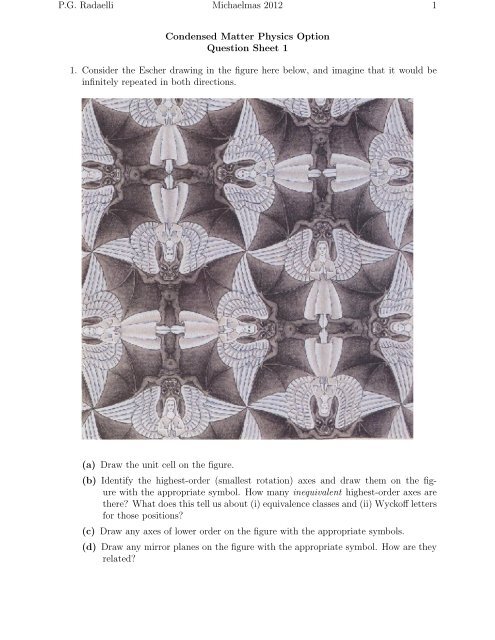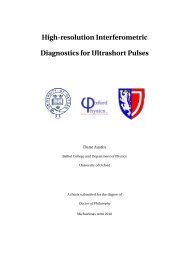Set 1
Set 1
Set 1
Create successful ePaper yourself
Turn your PDF publications into a flip-book with our unique Google optimized e-Paper software.
P.G. Radaelli Michaelmas 2012 1<br />
Condensed Matter Physics Option<br />
Question Sheet 1<br />
1. Consider the Escher drawing in the figure here below, and imagine that it would be<br />
infinitely repeated in both directions.<br />
(a) Draw the unit cell on the figure.<br />
(b) Identify the highest-order (smallest rotation) axes and draw them on the figure<br />
with the appropriate symbol. How many inequivalent highest-order axes are<br />
there? What does this tell us about (i) equivalence classes and (ii) Wyckoff letters<br />
for those positions?<br />
(c) Draw any axes of lower order on the figure with the appropriate symbols.<br />
(d) Draw any mirror planes on the figure with the appropriate symbol. How are they<br />
related?
P.G. Radaelli Michaelmas 2012 2<br />
(e) Are there any roto-translation operators (glides)? If so, draw them with the appropriate<br />
symbols.<br />
(f) Using the decision tree provided in the handouts (lecture 1, page 34) determine<br />
the ”wallpaper” group describing the symmetry of the drawing.<br />
2. A monoclinic crystal has lattice parameters a = 0.6nm, b = 0.7nm and c = 0.8nm<br />
and β=110 ◦ .<br />
(a) Find the magnitude of the length denoted by the direction [312].<br />
(b) Find the interplanar spacing d for planes given by (312).<br />
(c) Find the angle between the [312] direction and the normal to the plane (312).<br />
(d) Draw to scale the h0l section of the reciprocal lattice.<br />
(e) Suppose that initially an X-ray beam of wavelength 0.154nm is incident along<br />
the [100] direction. The crystal is then rotated through an angle α about [010]<br />
until the 002 reflection is obtained at a suitably placed detector. By construct the<br />
elastic scattering triangle, show how this arises with your drawing of the reciprocal<br />
lattice and calculate the angle of rotation of the crystal.<br />
3. USi crystallises in space group Pbnm, with a = 0.565nm, b = 0.765nm and c =<br />
0.390nm and Z = 4 (i.e. four USi groups per unit cell). For this space group the<br />
general equivalent positions are<br />
x, y, z x, y, 1 − z 1<br />
+ x, 1 − y, z 1<br />
+ x, 1 − y, 1 + z<br />
2 2 2 2 2 2<br />
x, y, z x, y, 1 + z 1<br />
− x, 1 + y, z 1<br />
− x, 1 + y, 1 − z<br />
2 2 2 2 2 2<br />
Given that all four U atoms have z = ± 1 , satisfy for yourself that the four U atoms<br />
4<br />
lie at the positions<br />
± { x, y, 1 4 ; 1 2 − x, 1 2 + y, 1 4<br />
(a) Obtain an expression for the structure amplitude for the U atoms alone and for<br />
a generic hkl. You may find it useful to write different expressions for different<br />
combinations of even and odd hkl.<br />
(b) We are now interested in using diffraction data to determine the exact location<br />
of the U atoms. Because in the arbitrariness in the choice of the origin, it is<br />
sufficient to limit our search to the range x < 1 and y < 1 . Would measuring the<br />
4 4<br />
intensities of the reflections 200, 111, 231 and 040 be sufficient to determine the<br />
solution uniquely?<br />
(c) A powder diffraction experiment is performed on USi using copper K α radiation<br />
(1.542 Å). From the measured intensity data below, determine approximate values<br />
for the positions x U and y U (the Si contributions can be neglected — why is<br />
this?). In the table, f U is the uranium form factor at the appropriate value of<br />
sin θ/λ, ”LPG” is the combined Lorentz, polarization and geometrical factor.<br />
The reflection multiplicity (number of RL points contributing to the same powder<br />
peak) can be calculated from the Miller indices.<br />
}
P.G. Radaelli Michaelmas 2012 3<br />
hkl 111 200 211 040 231<br />
I 612 ∼ 0 150 ∼ 0 233<br />
2θ (deg.) 30.12 31.6 40.09 47.41 53.70<br />
f U (sin θ/λ) 81 79 75 71 69<br />
LPG 13.4 12.8 6.8 4.9 3.7<br />
(d) Draw to scale the positions of the U atoms in the unit cell projected on (001).<br />
Calculate and mark on your diagram the shortest U-U distance in nm.<br />
4. A crystal contains two atoms at general positions in the unit cell. Suppose one of<br />
then has a real atomic scattering factor f 1 , while the second has a scattering factor f 2<br />
with real and imaginary components viz: f 2 = f ′ + if”. Write down the formulae for<br />
the structure amplitude for the hkl and hkl reflections, showing that Friedel’s law is<br />
untrue, i.e. show that I(hkl) ≠ I(hkl). Illustrate your answer on an Argand diagram.<br />
This is an example of anomalous dispersion, which can be used to tell whether a polar<br />
crystal is pointing up or down, or whether a chiral crystal is left or right-handed.<br />
5. Consider a general 2-dimensional rectangular lattice. Fig. 1 depicts the first Brillouin<br />
zone and four adjacent Wigner-Seitz cells, with a number of special symmetry points<br />
labelled.<br />
Figure 1:<br />
(a) What is the point-group symmetry of the reciprocal lattice? What are the possible<br />
wallpaper (plane) groups supporting this symmetry?<br />
(b) Imagine a metal with this lattice, where electrons interact with the lattice potential.<br />
The electronic states will form energy bands that disperse in the two
P.G. Radaelli Michaelmas 2012 4<br />
dimensions. Explain why the energy dispersion surfaces of each electronic band<br />
and the associated group velocities have the periodicity of the Reciprocal Lattice<br />
(RL) and the symmetry of the Laue class of the crystal. Is the Laue class different<br />
from the point-group (crystal class) symmetry?<br />
(c) Taking into account both symmetry and periodicity, show that at points Γ, X, Y<br />
and S the group velocities must be zero. Derive any constraits that might exist<br />
on the magnitude and direction of the group velocities at each of the other points<br />
C, ∆, Λ, D, Σ in Fig. 1.<br />
(d) Assuming that the energy dispersion has an absolute minimum at the Γ point<br />
and absolute maxima at the S points, and use the symmetry constraints, draw a<br />
plausible diagram of the constant-energy contours and of the velocities (indicated<br />
as arrows).<br />
(e) Consider now a more concrete example, using the “tight-binding” dispersion<br />
E = 5 − 4 cos k x − cos 2k y with a ∗ = 2π and b ∗ = π. (1)<br />
Plot the dispersion along the path S, Γ, ∆, Y, C, S, D, X, Σ, Γ and show that the<br />
symmetry constraints on the points with zero group velocity are verified by this<br />
dispersion. Finally, generate a two-dimensional computer plot of the whole dispersion<br />
curve and its gradient.<br />
(f) In the nearly-free electron model, applicable in the presence of a weak periodic<br />
potential U(r), the “perturbed” eigenfunctions with crystal momentum k are<br />
linear combination of degenerate free-electron wavefunctions with real momenta<br />
k + τ , τ being any reciprocal lattice vector (RLV ).<br />
• For each of the points Y , C and S in Fig. 1, write explicitly all the degenerate<br />
free-electron wavefunctions with momenta differing by τ .<br />
• Write the perturbed wavefunctions derived from point S and equivalents, knowing<br />
that they are either symmetric or antisymmetric by each of the two mirror<br />
symmetry planes. Write them both as real functions of r and by employing<br />
the Bloch form.










![Extended Notes 8 [pdf]](https://img.yumpu.com/50123548/1/190x245/extended-notes-8-pdf.jpg?quality=85)




![Handout 3 [pdf] - University of Oxford Department of Physics](https://img.yumpu.com/46475432/1/190x245/handout-3-pdf-university-of-oxford-department-of-physics.jpg?quality=85)